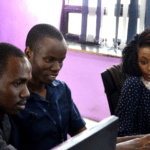A Generational Challenge: What We’ve Learned About Addressing Youth Unemployment
Noeline, in Uganda, had few options to make money after she became pregnant with her son. Living in a country with an extremely high rate of youth unemployment, the resources available to her were limited, and the job environment further constrained for a new mother.
Addressing youth unemployment globally, especially for girls like Noeline, may be one of the most complex development challenges of our time. Governments, nonprofits, donors, researchers, and multi- and bi-lateral organizations are investing an immense amount of resources, time and energy in solving it. But their efforts have yet to produce results on the scale necessary to truly make a dent in the problem. The global youth unemployment rate has hovered in the 12-13 percent range for decades – three times higher than the current adult unemployment rate of 4.3 percent. And the challenge is particularly acute in developing countries, where youth unemployment rates of 20 percent and above are distressingly common – and some countries have exceeded the 50 percent mark.
With its profound impact on national economies, international migration rates and individual lives, the youth unemployment challenge is an urgent global crisis. It’s clear more needs to be done.
On Monday (Sept. 24) some of the top development organizations, research institutes and donors in the world will come together to discuss a path forward at the Evidence to Action Forum: The Future of Work for Deprived Youth. Hosted by Save the Children, with support from Accenture and in partnership with BRAC, the Abdul Latif Jameel Poverty Action Lab and the International Initiative for Impact Evaluation, the event will explore what we in the global development community have, and haven’t, learned in our efforts to tackle this problem. The goal? To build consensus among researchers, implementers and donors around the priority research topics and create a five-year learning agenda on youth employment and livelihoods. It will also identify ways to translate research results into improved program design and implementation, and to collaborate on research, bringing together cross-sector expertise to tackle the challenge head-on.
Here are three key lessons that all parties invested, financially or otherwise, in addressing youth unemployment should take into account as they map out this learning agenda for the next five years.
Integrate research and implementation
Some of the most successful development programs globally came about because ongoing research verified or denied anecdotal assumptions that arose during program implementation. Take for example the Graduation approach, which BRAC developed over the course of 17 years in Bangladesh to tackle the equally nuanced challenge of overcoming ultra-poverty. Graduation, similar to many youth employment initiatives, is as multifaceted as the problem it was developed to tackle – with components that address health, nutrition, financial literacy, social empowerment, livelihood training and other services the very poorest people in a country need to overcome entrenched poverty.
Over the course of a decade, BRAC’s research and evaluation division published 23 working papers that examined questions from the program team. Researchers looked at everything from targeting participants, to engaging with village elders, to boosting social capital and economic wellbeing of the ultra-poor. Eight years later, a randomized control trial showed that the program had sustained economic and social effects for 95 percent of participants years after the program ended. Much of this success was due to the initial research that fostered effective program iteration.
Think long-term
The goal of youth employment programs is to equip young people with the skills they need to prepare for the future of work and to help identify or create pathways to employment. But anticipated labor market changes can have implication for how programs are designed, which depend on several factors: that there will be enough overall jobs in low-income countries for youth to increase their share; that current high-demand skill-sets will remain relevant in 10 years; and that companies will still have capacity to hire long-term employees. Because of these factors and their potential to shift, developing research and programs that only look at a young person’s entry into the workforce will not adequately address the problem.
In a report examining the root cause of unemployment in low- and low-middle- income countries, USAID concludes that the most effective investment is in demand-driven training that is aligned with local labor market demands. It explains that one of the best ways to support youth is with “policies and projects that increase the number of modern, labor-intensive enterprises by (1) helping established firms to grow and hire more workers and (2) encouraging new firms to enter into operation.” By taking demand-driven approaches, development actors can both better prepare youth for the future of work, while also ensuring that industries have a future of work to offer. However, creating new jobs is a difficult option in many of the developing economies in which we work. But we can equip youth with skills to adapt to changing job requirements and workplaces through transferable life skills, as Save the Children does through its youth integrated economic opportunities programming such as Skills to Succeed.
Build on the evidence
For this upcoming summit, participants will be examining nearly 30 evaluations of youth employment programs – all of which were published in the last five years. But even though many of these evaluations are looking at similar programs or contexts, they are still too disparate to compare. To truly build a body of evidence on youth employment, actors will need to start replicating effective approaches, and using existing tools or developing more robust approaches to ensure programs are contextually relevant and adapted to work within the social and capital constraints of the new settings. Additionally, researchers need to prioritize testing various innovations on the original models.
If donors, researchers and implementers can all get on the same page about what’s working and what isn’t, we could truly transform a generation. If we fail to effectively coordinate our resources, time and energy, then we risk damaging the lives – and hope – of young people around the world who deserve to fulfill their potential.
If you plan to attend the event on Monday, we look forward to hearing your thoughts then. If not, you can watch a livestream of the discussion here: It will run from 8:30 am to 12:30 pm, EDT.
Emily Coppel is a communications manager at BRAC USA.
Patricia Langan is a program director at Save the Children.
Image courtesy of Save the Children.
- Categories
- Impact Assessment



